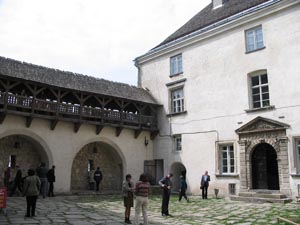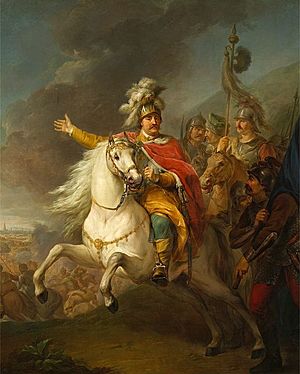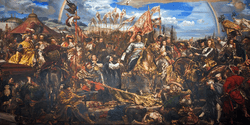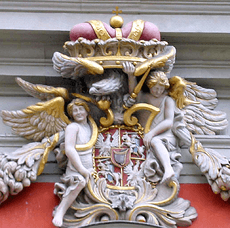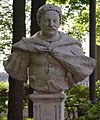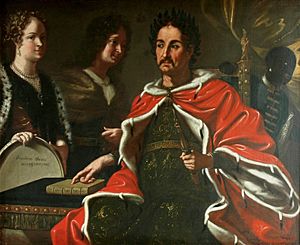John III Sobieski facts for kids
Quick facts for kids John III |
|
|---|---|
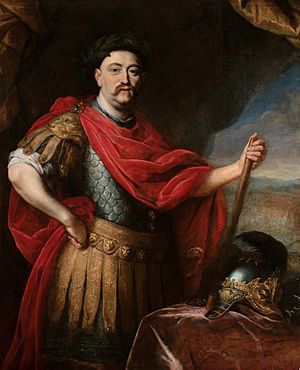
Portrait by Daniel Schultz
|
|
| King of Poland Grand Duke of Lithuania |
|
| Reign | 19 May 1674 – 17 June 1696 |
| Coronation | 2 February 1676 |
| Predecessor | Michael |
| Successor | Augustus II the Strong |
| Born | 17 August 1629 Olesko Castle, Olesko, Polish–Lithuanian Commonwealth |
| Died | 17 June 1696 (aged 66) Wilanów Palace, Warsaw, Polish–Lithuanian Commonwealth |
| Burial | Wawel Cathedral, Kraków |
| Spouse | Marie Casimire Louise de La Grange d'Arquien |
| Issue among others... |
James Louis Sobieski |
| House | Sobieski |
| Father | Jakub Sobieski |
| Mother | Zofia Teofillia Daniłowicz |
| Religion | Roman Catholicism |
| Signature | 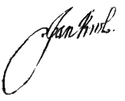 |
John III Sobieski (born 17 August 1629 – died 17 June 1696) was a famous king of Poland and Grand Duke of Lithuania. He ruled from 1674 until his death. He is known as one of the most important leaders of the Polish–Lithuanian Commonwealth.
King Sobieski was a very skilled military leader. He was especially good at fighting against the Ottoman Turks. His 22 years as king brought stability to the Commonwealth. This was much needed after many years of wars and rebellions. People liked him a lot. He is most famous for his big victory over the Turks at the Battle of Vienna in 1683. After his wins, the Ottomans called him the "Lion of Lechistan." The Pope even called him the "savior of Christendom."
Contents
Royal Titles
When John III Sobieski was king, his full official title in Latin was: Joannes III, Dei Gratia rex Poloniae, magnus dux Lithuaniae, Russiae, Prussiae, Masoviae, Samogitiae, Livoniae, Smolenscie, Kijoviae, Volhyniae, Podlachiae, Severiae, Czernichoviaeque, etc.
In Polish, it was: Jan III, z łaski bożej, król Polski, wielki książę litewski, ruski, pruski, mazowiecki, żmudzki, kijowski, wołyński, podlaski i czernichowski, etc.
This means in English: John III, by the grace of God King of Poland, Grand Duke of Lithuania, Ruthenia, Prussia, Masovia, Samogitia, Livonia, Smolensk, Kiev, Volhynia, Podlasie, Severia, and Chernihiv, etc.
Life Story
Early Life and Education
John Sobieski was born on 17 August 1629. His birthplace was Olesko, which is now in Ukraine. At that time, it was part of the Polish–Lithuanian Commonwealth. He came from a well-known noble family called Sobieski.
His father, Jakub Sobieski, was a high-ranking official. His mother, Zofia Teofillia Daniłowicz, was the granddaughter of a famous military commander. John grew up in Żółkiew. He went to college in Kraków and then studied philosophy at the Jagiellonian University.
After his studies, John and his brother Marek traveled around Western Europe for over two years. They visited many important cities like Paris and London. During this time, he met famous people and learned French, German, and Italian. He already knew Latin.
Becoming a Commander
Both brothers returned home in 1648. They joined the army when they heard about the king's death and a big rebellion. They fought in several battles. Sadly, his brother Marek died in 1652.
John, however, became a very promising commander. He was promoted to the rank of pułkownik (a high military rank). He even went on a diplomatic mission to the Ottoman Empire. There, he learned the Tatar and Turkish languages. He also studied their military ways.
When Sweden invaded Poland in a war called "The Deluge," John first joined the Swedish side. But he soon left them and returned to fight for the Polish king. He was given the important position of chorąży koronny (Standard-bearer of the Crown) in 1656.
He led a cavalry regiment in the Battle of Warsaw. He also fought in many other battles over the next few years. In 1665, he married Marie Casimire Louise de la Grange d'Arquien. He was then promoted to Grand Marshal of the Crown.
In 1667, he won another important victory against the Cossacks and Tatars at the Battle of Podhajce. This helped him regain his reputation as a great military leader. In 1668, he became Grand Hetman of the Crown. This was the highest military rank in the Commonwealth. It made him the commander-in-chief of the entire Polish Army.
Becoming King
On 11 November 1673, Sobieski won a huge victory. He defeated the Ottomans at the Battle of Khotyn. The news of this battle came at the same time as the death of King Michal. This made Sobieski one of the most important people in the country.
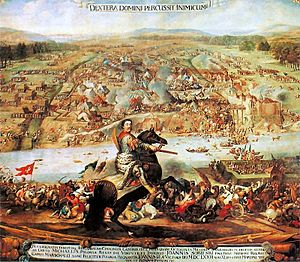
So, on 19 May 1674, he was chosen to be the new king of the Commonwealth. Almost everyone supported him. Because there was still a war going on, his coronation was delayed. He was finally crowned John III almost two years later, on 2 February 1676.
King of Poland-Lithuania
When Sobieski became king, Poland-Lithuania was a very large country. But it had been badly damaged by many years of war. The country's money was almost gone. The powerful nobles often worked with foreign countries instead of helping their own state.
Sobieski had big plans. He wanted to start his own royal family line in the Commonwealth. He also wanted to get back lost lands and make the country stronger. One of his biggest dreams was to unite Christian Europe. He wanted to lead a "crusade" to push the Turks out of Europe.
First, he had to deal with the Ottoman threat in the south. In 1674, he started fighting the Ottomans again. He managed to take back several cities and fortresses. This helped create a strong defense line in Ukraine. In 1675, he stopped a Turkish and Tatar attack on Lviv.
In 1676, a peace treaty was signed. This treaty gave Poland some towns back, but some land remained with the Ottomans. This peace allowed Sobieski to fix up the country. He completely reformed the Polish army. He made the army into new groups called regiments. The soldiers stopped using long spears and started using battle-axes. The cavalry (horse soldiers) also changed their fighting styles. Sobieski also got many more cannons and taught new ways to use artillery.
Sobieski wanted to take control of Prussia. He even made a secret treaty with France and Sweden for this. But his plans didn't work out. Many Polish nobles were against him. Some even wanted to remove him as king.
By 1683, Sobieski realized Poland needed strong friends. He made an alliance with Leopold I, the Holy Roman Emperor. They promised to help each other if their capital cities were in danger. This alliance was the start of the Holy League. This group was supported by Pope Innocent XI. Its goal was to protect Christian Europe.
In the spring of 1683, spies found out that the Turks were preparing for a big war. Sobieski worried they would attack Polish cities like Lwów and Kraków. He ordered cities to build defenses and called for everyone to join the army. In July, Austria asked Poland for help. Soon, the Polish army gathered to fight the Ottomans. In August, they were joined by soldiers from Bavaria and Saxony.
The Battle of Vienna

John Sobieski's most famous victory happened in 1683. It was the Battle of Vienna. He led Polish and German troops against the invading Ottoman Turks. The Ottoman army, led by Kara Mustafa, was close to breaking through Vienna's walls.
On 12 September, Sobieski arrived in Vienna and ordered a full attack. In the early morning, about 65,000 to 76,000 soldiers (including 22,000 to 27,000 Poles) attacked the Turkish force of about 143,000 men. Around 5 PM, Sobieski led the Polish cavalry, called husaria, along with Austrian and German soldiers. They charged down a hillside.
The Ottoman battle line quickly broke, and their forces ran away in confusion. By 5:30 PM, Sobieski entered Kara Mustafa's empty tent. The Battle of Vienna was over.
The Pope and other important people from other countries praised Sobieski. They called him the "Savior of Vienna and Western European civilization." He wrote to his wife, "All the common people kissed my hands, my feet, my clothes; others only touched me, saying: 'Ah, let us kiss so valiant a hand!'"
The war with the Ottomans continued. Sobieski fought in the Battle of Párkány in October. After some early wins, Poland became a smaller partner in the Holy League. They didn't gain much new land or power. The long war also made Sobieski's position at home weaker. For the next four years, Poland blocked the important fortress at Kamenets. Ottoman Tatars continued to raid the border areas. In 1691, Sobieski led another expedition, but it didn't bring a decisive victory.
Later Years and Death
Even though King Sobieski spent a lot of time fighting, he became very ill towards the end of his life.
King John III Sobieski died in Wilanów, Poland, on 17 June 1696. He had a sudden heart attack. His wife, Marie Casimire Louise, died later in 1716 in France. Her body was brought back to Poland. They are buried together in Wawel Cathedral in Kraków, Poland. Augustus II the Strong became the next king.
Legacy and Significance
John Sobieski is remembered in Poland as a "hero king." He is famous for his victory at Vienna, which stopped the Ottoman threat. This image became very popular in stories and books in the 1800s.
He was a very smart military leader. He was also well-educated and loved reading. He supported scientists and artists. For example, he helped the astronomer Johannes Hevelius and the mathematician Adam Adamandy Kochański. His Wilanów Palace became a model for many beautiful palaces built later in the Commonwealth.
He loved his wife very much and often listened to her advice. However, he was not able to fix all the problems of the Commonwealth. He also couldn't make sure his son would become the next king.
Gallery
-
Scutum Sobiescianum "Shield of Sobieski" in the sky, from a map by Johannes Hevelius in 1690.
-
A statue of John III Sobieski in Przemyśl.
-
Monument of Sobieski in Warsaw.
-
Monument in Gdańsk, moved from Lwów after World War II.
-
A bust of John III Sobieski in the Polish Institute and Sikorski Museum in London.
-
A bust of John III Sobieski in Saint Petersburg.
Family
On 5 July 1665, John Sobieski married Marie Casimire Louise de la Grange d'Arquien. She was from France. They had several children together:
- James Louis Sobieski (1667–1737), who was the Crown Prince of Poland. He married Countess Palatine Hedwig Elisabeth of Neuburg and had children.
- Twin Daughters (born and died 1669).
- Teresa Teofila (born and died 1670), a frail child.
- Adelajda Ludwika (1672–1677), who died at age four.
- Maria Teresa (1673–1675), who died at age two.
- Daughter (born and died 1674).
- Teresa Kunegunda (1676–1730). She married Maximilian II Emanuel, Elector of Bavaria and had children.
- Aleksander Benedykt (1677–1714), who never married.
- Daughter (born and died 1678).
- Konstanty Władysław (1680–1726). He married Maria Józefa Wessel but had no children.
- Jan (1682–1685), who died at age two.
- Daughter (born and died 1684).
Sobieski Family Gallery
-
Portrait of Maria Klementyna, John III's granddaughter, painted around 1735.
Images for kids
-
Sobieski defeats the Ottoman Turks at the Battle of Vienna in 1683, by Martino Altomonte.
See also
 In Spanish: Juan III Sobieski para niños
In Spanish: Juan III Sobieski para niños


